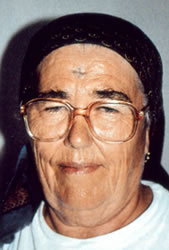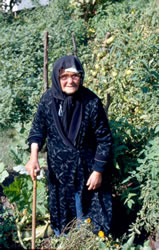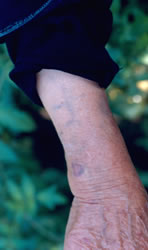Tattooing in North Africa, The Middle East and Balkans
Article © 2010 Lars Krutak
THE VLACHS
The indelible tradition of tattooing in the Balkans also permeated a small number of indigenous groups living in northwest Greece. In the remote vastness of the Píndhos Mountains lives a population of Orthodox Christians called the Vlachsor Roumaní. The origins of the Vlachsare obscure, shrouded as they are by time, and most historians agree that they are the last remnants of the Latin speaking population that existed in the Balkans since the incorporation of ancient Macedonia into the Roman Empire in 148 B.C. Their unwritten language – Arouman – has Latin origins and can be described as a proto-Romance language mutually comprehensible to modern Romanian.

|
During Roman times the Via Egnata, an old Roman road and trade route connecting Constantinople to the Adriatic, was heavily guarded by Legionnaires who in turn trained indigenous shepherds and herdsmen along its route for military work in the high mountain passes. Greek Vlachs probably learned Latin through these working associations and down through the millennia preserved it in undisturbed form in the highlands of the largely inaccessible Píndhos.
As late as the early 15th century, the Vlachswere a powerful independent kingdom in parts of Bulgaria and Greece. But within a century the Ottoman Turks conquered the Balkans and most of Eastern Europe eventually collapsing Vlach autonomy in their core area for the next six-hundred years. |
Crucifix tattoo on the forehead of a Bosnian
woman, 2000. Photograph © Michael Laukien. |
Today, the Vlachsare a minority population in an overwhelmingly Greek state. But they continue to retain their traditional dress, language, and indelible customs – including tattoo. Although increasingly rare, traditional Vlachtattoo exists on only a handful of elderly women in the Píndhos region. These marks, tattooed on the skin by old Vlachwomen, not only reaffirmed their Orthodox Christian belief, but also affected powerful charms against the evil eye and other disease spread by spirits encountered while herding sheep and other domesticates in the wilderness. |
|
Lampblack, the finely powdered soot derived from charcoal, was chosen as tattoo pigment because it was believed to have purificatory power. Charcoal was utilized at Vlach funerals to not only repel the spirit of the recently deceased, but also to prevent spirit possession. Through such associations, it would seem that Vlach tattoo pigment perhaps held baraka-like power, acting to both purify and protect the physical body from disembodied metaphysical forces met in the local landscape.
 
|
|
Tattooed Vlach woman. Giannoula Giannaki was born in Albania in 1906 and later moved to northern Greece. At the time of this photograph (2002) she was one of only a handful of tattooed Aromanian Vlachs still living in Greece. Giannoula wears a large, faded cruciform design on her right forearm and forehead. Her mother wore five cruciforms upon her brow. Photographs © Lars Krutak. |
LITERATURE
Bourdieu, P. (1990). The Logic of Practice. Stanford: Stanford University Press.
Cola Alberich, J. (1949). Amuletos y tatuajes marroquíes. Madrid: Instituto de Estudios Africanos.
Coon, C.S. (1931). Tribes of the Rif. Cambridge, MA: Peabody Museum of Harvard University.
Durham, M.E. (1929). Some Tribal Origins, Laws, and Customs of the Balkans. New York: Macmillan Co.
El Guindi, F. (1999).Veil: Modesty, Privacy, and Resistance. Oxford: Berg.
Fernea, E.W. (1965). Guests of the Sheik: An Ethnography of an Iraqi Village. Garden City, NY: Doubleday, Anchor Books.
Field, H. (1958). “Body-Marking in Southwestern Asia.” Papers of the Peabody Museum of
Archaeology and Ethnology, Harvard University XLV, no. 1.
Gobert, E. (1924). “Notes sur les tatouages des indigénes tunisiens.” L’Anthropologie 34 : 57-90.
-(1956). “Remarques sur les tatouages nord-africains.” Revue Africaine 100: 446-449.
Herber, J. (1921). “Tatouages marocains: tatouage et religion.” Revue de l’Histoire des Religions 83: 69-83.
-(1923). “Les tatouages du pied au Maroc.” L’Anthropologie 33: 87-102.
-(1946). “Les tatouages de la face chez la Marocaine.” Hespéris 33(3-4): 323-351.
-(1949). “Les tatouages du cou, de la poitrine et du genou chez la Marocaine.” Hespéris 36(3-4): 333-346.
Izady, M.R. (1992). The Kurds: A Concise Handbook. London: Crane Russak.
-(1993). “Exploring Kurdish Origins.” Kurdish Life 7: 2-6.
Jereb, J.F. (1996). Arts and Crafts of Morocco. San Francisco: Chronicle Books.
Kapchan, D. (1993). “Moroccan Women’s Body Signs.” Pp. 3-35 in Bodylore (K. Young, ed.). Knoxville: University of Tennessee Press.
Krutak, L. (1999). “St. Lawrence Island Joint-Tattooing: Spiritual/Medicinal Functions and Inter-Continental Possibilities.” Études/Inuit/Studies 23(1-2): 229-252.
-(2003). “Landmines and Tough Times: Tattoo Art in Kosovo.” Skin and Ink. July. Pp. 61-67.
Laukien, M. (2000). “Die traditionellen tätowierungen der Katholiken Bosnien” [The Traditional Tattooing of the Bosnian Catholics]. TätowierMagazin. December. Pp.92-97.
-(2001). “Catholic Tattoos in Bosnia.” Skin and Ink. March. Pp.24-28.
Searight, S. (1984). The Use and Function of Tattooing on Moroccan Women. 3 vols. New Haven, Conn.: Human Relations Area Files.
Smeaton, W. (1937). “Tattooing Among the Arabs of Iraq.” American Anthropologist 39: 53-61.
Truhelka, C. (1896). “Die Tatowirung bei der Katholiken Bosniens und der Hercegovina.” Wissenschaftliche Minheilungen aus Bosnien und der Herzegowina, sv. 4. str. 493-508.
Westermarck, E. (1926). Ritual and Belief in Morocco. 2 vols. London: Macmillan and Company, Ltd.
Winnifreth, T. (1992). The Vlachs. London: Duckworth Press.
First Page | 1
|
2 |
3 |
4 |
5 |
6 |
7 |
8 |
Museum photo gallery of the images
on this page may be seen here. |



